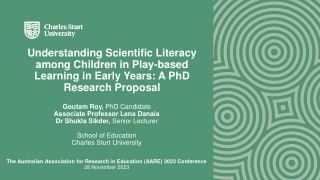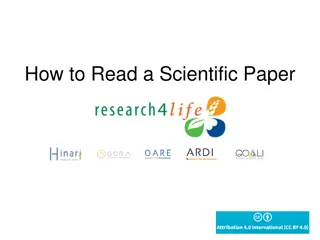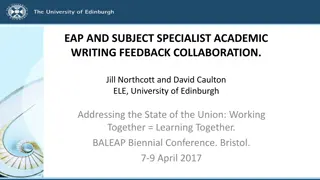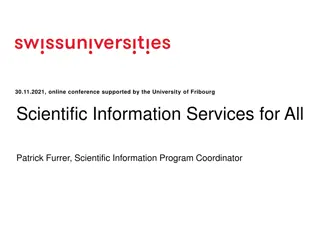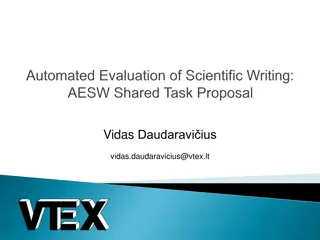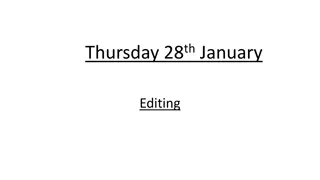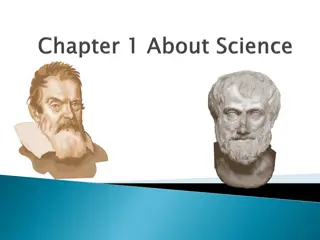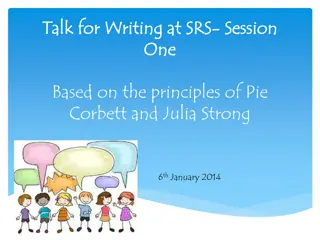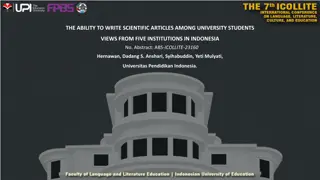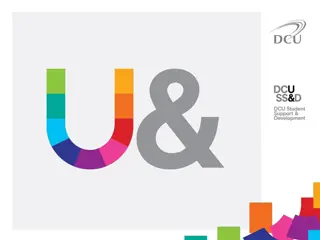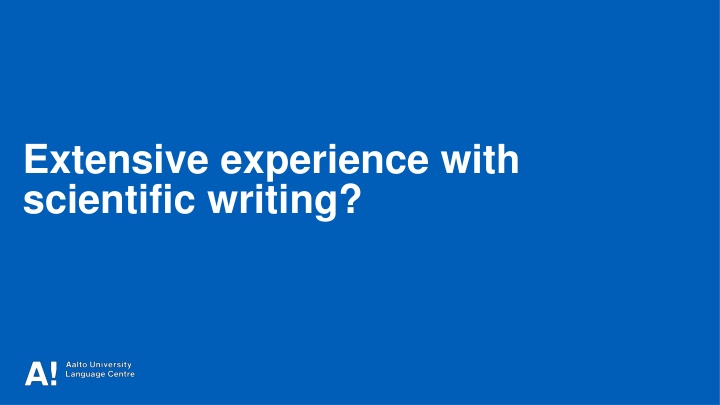
Effective Strategies for Scientific Writing Success
Enhance your scientific writing skills with expert guidance from Aalto University Language Centre. Explore writing courses and support available for mastering scientific writing, including tips on good writing practices and key principles to follow for clarity and accuracy in your academic papers.
Download Presentation

Please find below an Image/Link to download the presentation.
The content on the website is provided AS IS for your information and personal use only. It may not be sold, licensed, or shared on other websites without obtaining consent from the author. If you encounter any issues during the download, it is possible that the publisher has removed the file from their server.
You are allowed to download the files provided on this website for personal or commercial use, subject to the condition that they are used lawfully. All files are the property of their respective owners.
The content on the website is provided AS IS for your information and personal use only. It may not be sold, licensed, or shared on other websites without obtaining consent from the author.
E N D
Presentation Transcript
Extensive experience with scientific writing?
Worried about writing a paper of 60 pages or more?
Scientific Writing Aalto University Language Centre Susan Gamache susan.gamache@aalto.fi 28 Aug 2023
Writing courses Masters International students are required to take 3 credits of language studies that include oral & written skills LC-1310 Academic Communication for MSc students (o,w) (3 cr) You will write and present on a topic from your own field (usually based on previous BSc research or ongoing MSc research) LC-1317 Integrated Project Communication for MSc students (o,w) (3 cr) This option is only available to students in the EMC program as it s integrated into Field Experience and Project in Hard Rock Mining
Support when writing your Master s thesis LC-1322 Thesis writing for engineers (w) (3 cr) Writing clinic 8 free one-on-one session with a Language Centre teacher to help you improve your writing. In person or via Zoom. Book through MyCourses
What is good Scientific Writing?
Do you agree? Good writing is mostly about using standard grammar, incorporating disciplinary vocabulary, and good mechanics. Good writing is subjective. Every reader wants something different. Scientific writing requires complicated sentences and long words. Great writers are born, not made https://www.menti.com/alrhm92x9prr
1. 2. 3. 4. 5. 6. 7. 8. Objectivity Complexity: lexically and grammatically more complex Formality Precision with facts & figures Explicitness: signposting / linking ideas Accuracy: narrow specific terminology Hedging: cautious language indicating a degree of certainty Responsibility: support claims with evidence, use sources, critically assess sources Gillet, 2015
Cultural differences in writing Reader-responsible vs. writer-responsible writing cultures
Reader-responsible culture The responsibility is on the READER to understand the message. Avoid stating the obvious Avoid repetition Preference for complicated structures
Writer-responsible culture The responsibility is on the WRITER to make the message understandable. Give a lot of background information Repetition and summaries Language is relatively clear and simple
Writer-responsible writing cultures: Australia, Canada, Great Britain, Ireland, Netherlands, New Zealand, Singapore, South Africa, United States Reader-reponsible writing cultures: Argentina, Brazil, China, Columbia, East Africa, Ecuador, Greece, Guatemala, Hong Kong, Jamaica, Japan, Malaysia, Malta, Morocco, Pakistan, Panama, Peru, Poland, Portugal, Romania, Russia, Salvador, Serbia, Slovakia, Slovenia, South Korea, Spain, Suriname, Turkey, Uruguay, Vietnam Mixture: Arab Countries, Austria, Bangladesh, Belgium, Bulgaria, Chile, Costa Rica, Croatia, Czech Republic, Denmark, Estonia, Finland, France, Germany, Indonesia, India, Iran, Italy, Luxembourg, Norway, Philippines, Sweden, Switzerland, Taiwan, Thailand, Trinidad, Venzuela Source: McCool, M. (2009, p.123). Writing Around the World: Guide to Writing Across Cultures. Continuum International Publishing Group Ltd.
What is plagiarism? Stealing ideas or language from another source without giving credit for it Intentional plagiarism / unintentional plagiarism Image: Heath Robinson, 2018, Creative Commons license Harvard University Library, 2012
Originality assessment tool All theses must go through Turnitin. Freely available for Aalto students Use it to improve your citation skills & avoid plagiarism https://wiki.aalto.fi/display/turnitin/Turnitin+for+students
Is this a good citation practice? Additive manufacturing was originally developed to guide product design by providing a way to create prototypes directly from digital designs. This method called rapid prototyping (RP), as the name implies, consumes less time and resources than most preceding techniques. For instance, the manufacturing of an injection mold for prototyping purposes would be extremely expensive. However, the part can be created with additive manufacturing for a fraction of the cost. Moreover, rapid prototyping is cost and time effective when it can substitute handcrafting, CNC manufacturing, or silicon molding. The downside when compared to these methods is often poor surface quality and inferior dimensional accuracy. However, RP enables fast iterative testing of products with a low threshold of prototypes failing expectations. This makes it a superior tool in product development and explains why prototyping has been the leading application of AM. (Wohlers 2013) Source: Kukko-Liedes, 2015. Used under CC license.
Topical progression Chen and Liu (2004) studied the effect of aggregate size distributions and the volume fraction of aggregate on the fracture parameters of concretes with strength 50 89 MPa under three-point bending test. For this purpose three various maximum aggregate sizes of 10, 15 and 20 mm were employed. They also investigated the influence of coarse aggregate volume fraction on the fracture parameters of HSC. For this purpose three various volume fraction of aggregates named 40 %, 60 % and 80 % were employed. They concluded that HSC with lower brittles could be made by aggregate with greater size. The maximum fracture energy and fracture toughness were achieved at 60 % of aggregate volume. (Rashad and Seleem, 2017)
Topical progression Chen and Liu (2004) studied the effect of aggregate size distributions and the volume fraction of aggregate on the fracture parameters of concretes with strength 50 89 MPa under three-point bending test. For this purpose three various maximum aggregate sizes of 10, 15 and 20 mm were employed. They also investigated the influence of coarse aggregate volume fraction on the fracture parameters of HSC. For this purpose three various volume fraction of aggregates named 40 %, 60 % and 80 % were employed. They concluded that HSC with lower brittles could be made by aggregate with greater size. The maximum fracture energy and fracture toughness were achieved at 60 % of aggregate volume. (Rashad and Seleem, 2017)
Which essential element is still missing from the previous citation example? Your own voice!
Want to learn more? Sign up for a Master s Writing Course https://shorturl.at/entuL

